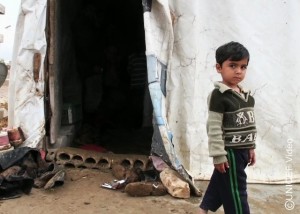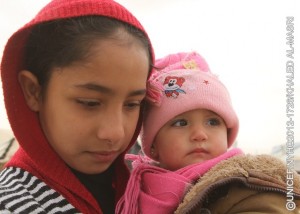在黎巴嫩,「過冬計劃」援助面臨惡劣天氣的敘利亞難民
2012-12-21
在此營地生活的難民,更確切地形容的話,在此「求生」的難民,幾乎都是身無長物。他們從黎巴嫩邊境穿越到此。隨着冬季來臨,這裡的溫度往往降至攝氏0度以下,並時常下雪。
前天,傾盆大雨澆透了帳篷,讓難民原本艱難的生活環境雪上加霜。這些棚屋由硬紙板、塑膠和石頭臨時搭建而成,根本無法抵禦寒冬。兒童要在鞋子外面套上塑膠袋,以防泥濘弄髒鞋子。
 |
 |
截至2012年12月19日,聯合國難民署估計超過16.3萬人正在黎巴嫩,登記或等待登記成為敘利亞難民。
然而,相信實際數字遠高於此,因為許多敘利亞人基於人身安全或其他原因,未有登記。黎巴嫩已成為該地區中,接收敘利亞難民人數最多的國家之一。
約3.5萬名0至14歲流離失所的敘利亞兒童,現正位處黎巴嫩北部和貝卡地區,這些地區都正面臨極端的寒冬。上周,約270名在黎巴嫩避難的敘利亞難民急需入院救治,突顯了身處在敘利亞的難民家庭活於絕對之中,生活條件有多危險。隨着寒冬迫近,聯合國兒童基金會(UNICEF)的首要任務就是幫助這些兒童保暖,保障他們的的安全和健康。
權宜之計
自2012年9月起,12歲的亞海亞(Yahya)*和他的家人在這所營地尋求庇護。亞海亞一家沒有毯子,亦沒有錢買木柴,只能依靠起初搭建的煙囪,燒一些在垃圾堆或路上撿到的塑膠抵禦寒冷。
亞海亞說:「我們沒有東西可用來取暖。大家都要取暖,但都沒有辦法。我們只需要毯子保暖,但我們連一條毯子都沒有。」亞海亞現在還穿着剛抵達黎巴嫩時穿的衣服,但根本不足以抵禦寒冷的天氣和雨水。
| 哈南(Hanan)和她的家人缺少基本的個人及環境衞生設施。廁所是基本設施,但她們的「廁所」,通常只是在地上挖一個坑。 麗娜(Lina)家的「廁所」溢出糞便,令周圍變成了一個污水溝。她表示:「都氾濫了!下雨的時候,雨水流進廁所,夾雜着糞便湧了出來。所以我們不得不另挖一個坑。我們還能做些什麼呢?」 |
 |
廁所「氾濫」,令細菌肆意傳播,再加上無法保持適當的個人及環境衞生,令營地的水媒疾病如肝炎和霍亂的傳染風險都相當高。
在貝卡谷地內一個名為亞道斯(Adous)的偏遠小村莊,一名黎巴嫩居民阿布德.穆斯塔法(Abood Mustafa)表示入院人數不斷上升,恐怕冬季的入院人數會只增不減。他說:「我們盡力幫忙,砍伐了一些樹木。我們正在想辦法解決問題……但是仍有許多人沒有水箱、濾水器、毯子或床褥。他們穿越邊境進入黎巴嫩時,基本上是一無所有。」
幫助有風險的家庭
| UNICEF及其合作伙伴正在黎巴嫩推行一項「過冬計劃」,為阿卡爾(Akkar)、黎巴嫩北部和貝卡谷地的難民提供保暖衣物。UNICEF已開始為敘利亞難民兒童提供冬季衣服。組織正援助3萬名兒童,其中一半兒童收到的保暖衣物套裝,內有鞋、襪子、褲子、外套、帽子、手套和緊身衣,另一半兒童收到在附近市場購買服裝的現金代用券。 敘利亞難民還將收到毯子、塑膠薄膜、家庭衞生箱和嬰兒用品箱。有關人員正計劃分發藥品和營養用品。 據UNICEF駐黎巴嫩的供應和物流專員奧利維爾.穆萊特(Olivier Mulet)表示,難民身處的情況每天都在惡化,因此時間十分緊迫,他說:「我們檢視了當地市場的需要,決定發放現金代用券,因為這種方法收效非常快。」 |
 |
*為保護兒童身份,文中人名均為化名。
您的捐款能夠拯救兒童的生命!
 |
 |
 |
| 港幣194元 為3個月大嬰兒提供禦寒衣物 | 港幣438元 為兒童提供1套保暖衣物套裝 | 港幣826元 為15名嬰兒提供毛毯 |
| 請即捐款! |









